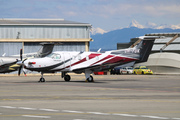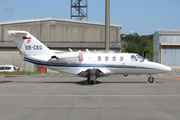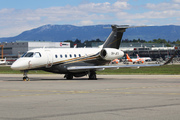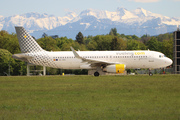Dépêches
EMS Aviation In-flight Communications System Selected by Anderson Air
Dépèche transmise le 25 juillet 2011 par Business Wire

EMS Aviation In-flight Communications System Selected by Anderson Air
ATLANTA--(BUSINESS WIRE)--EMS Aviation, a division of mobile connectivity leader, EMS Technologies, Inc. (NASDAQ:ELMG) announced today that Vancouver, British Columbia-based Anderson Air has selected the Aspire™ 200 LG airborne communications system for its Cessna® Sovereign aircraft. Anderson Air operates the aircraft for a Canadian company.
“Connectivity has become an essential part of our flight operations, and passengers expect to be able to make a call and have Internet access while in-flight”
“Interest in our Aspire product line from aircraft operators, OEMs and our dealer network continues to ramp-up,” said John Jarrell, Vice President and General Manager, EMS Aviation. “EMS has been delivering satellite communications systems for more than 20 years, and in that time we’ve learned that flexibility, ease of installation and ability to upgrade are what drive system selection. We are extremely pleased to work with Anderson Air to provide their customer with our best-in-class in-flight connectivity system.”
The Aspire 200 system, to be installed in Anderson Air’s Cessna Sovereign aircraft, includes a CNX® 200 Network Accelerator and is designed to deliver feature-rich voice and data connectivity to owners and operators of small- and medium-sized business aircraft. Key features of the Aspire system include standard wiring configuration and interfaces that support either Iridium or Inmarsat components. Operators can easily upgrade systems without rewiring the cabin or changing out the avionics racks. The system can be upgraded by exchanging the Aspire CSU Iridium (voice and low-speed data) transceiver for the Inmarsat HDU (voice and high-speed data) transceiver, and also by adding a higher gain Inmarsat antenna. Aspire’s Inmarsat system data rates run from up to 200 kbps with a low-gain antenna, to 330 kbps with an intermediate-gain antenna and 432 kbps with a high-gain antenna.
“Connectivity has become an essential part of our flight operations, and passengers expect to be able to make a call and have Internet access while in-flight,” says General Manager David Anderson, Anderson Air. “In this particular case, the company flies regularly to South America and Europe, and needs voice and data contact during the long flights. We selected the Aspire solution because it fits our own and our customer’s requirements and it also offers an easy upgrade path to even greater bandwidth if needed.”
About EMS Technologies
As one of the world’s leading providers of wireless connectivity solutions, EMS Technologies, Inc. keeps people and systems connected — on land, at sea, in the air or in space. EMS offers industry-leading technology to support Aero Connectivity and Global Resource Management markets through a broad range of cutting-edge satellite and terrestrial network products; helping businesses, assets and people stay connected and promoting universal mobility, visibility and intelligence. EMS (NASDAQ:ELMG) serves customers through operations in 12 countries.
EMS Aviation, a division of EMS Technologies, Inc., is a leading supplier of connectivity and in-cabin infrastructure equipment for a broad range of commercial and military aircraft. EMS Aviation’s products and services are designed to enable reliable worldwide Internet connectivity and in-flight entertainment, satellite-based messaging and tracking, rugged data management and storage, and data record and replay. The division is a leader in Inmarsat®, Iridium, Ku band and air-to-ground mobile connectivity solutions, with proven commercial off-the-shelf (COTS) systems.
Forward-Looking Statements
Statements contained in this press release regarding the Company’s expectations for its financial results for 2011 and the potential for various businesses and products are forward-looking statements. Actual results could differ materially from those statements as a result of a wide variety of factors. Such factors include, but are not limited to economic conditions in the U.S. and abroad and their effect on capital spending in our principal markets; difficulty predicting the timing of receipt of major customer orders, and the effect of customer timing decisions on our results; our successful completion of technological development programs and the effects of technology that may be developed by, and patent rights that may be held or obtained by, competitors; U.S. defense budget pressures on near-term spending priorities; uncertainties inherent in the process of converting contract awards into firm contractual orders in the future; volatility of foreign currency exchange rates relative to the U.S. dollar and their effect on purchasing power by international customers, and on the cost structure of the our operations outside the U.S., as well as the potential for realizing foreign exchange gains and losses associated with assets and liabilities denominated in foreign currencies; successful resolution of technical problems, proposed scope changes, or proposed funding changes that may be encountered on contracts; changes in our consolidated effective income tax rate caused by the extent to which actual taxable earnings in the U.S., Canada and other taxing jurisdictions may vary from expected taxable earnings, changes in tax laws, and the extent to which deferred tax assets are considered realizable; successful transition of products from development stages to an efficient manufacturing environment; changes in the rates at which our products are returned for repair or replacement under warranty; customer response to new products and services, and general conditions in our target markets (such as logistics and space-based communications) and whether these responses and conditions develop according to our expectations; the increased potential for asset impairment charges as unfavorable economic or financial market conditions or other developments might affect the estimated fair value of one or more of our business units; the success of certain of our customers in marketing our line of high-speed commercial airline communications products as a complementary offering with their own lines of avionics products; the availability of financing for various mobile and high-speed data communications systems; risk that unsettled conditions in the credit markets may make it more difficult for some customers to obtain financing and adversely affect their ability to pay, which in turn could have an adverse impact on our business, operating results and financial condition; development of successful working relationships with local business and government personnel in connection with distribution and manufacture of products in foreign countries; the demand growth for various mobile and high-speed data communications services; our ability to attract and retain qualified senior management and other personnel, particularly those with key technical skills; our ability to effectively integrate our acquired businesses, products or technologies into our existing businesses and products, and the risk that any such acquired businesses, products or technologies do not perform as expected, are subject to undisclosed or unanticipated liabilities, or are otherwise dilutive to our earnings; the potential effects, on cash and results of discontinued operations, of final resolution of potential liabilities under warranties and representations that we made, and obligations assumed by purchasers, in connection with our dispositions of discontinued operations; the availability, capabilities and performance of suppliers of basic materials, electronic components and sophisticated subsystems on which we must rely in order to perform according to contract requirements, or to introduce new products on the desired schedule; uncertainties associated with U.S. export controls and the export license process, which restrict our ability to hold technical discussions with customers, suppliers and internal engineering resources and can reduce our ability to obtain sales from customers outside the U.S. or to perform contracts with the desired level of efficiency or profitability; our ability to maintain compliance with the requirements of the Federal Aviation Administration and the Federal Communications Commission, and with other government regulations affecting our products and their production, service and functioning; and costs associated with a recent announcement by one of shareholders that it intends to nominate four directors to our Board. Further information concerning relevant factors and risks are identified under the caption “Risk Factors” in our Annual Report on Form 10-K for the year ended December 31, 2010.
- 17:03 Norse Atlantic Airways s'envole vers Las Vegas
- 16:53 easyJet a réceptionné son 400e Airbus
- 16:44 Icelandair : résultats mars 2024
- 16:31 Air France dévoile une nouvelle campagne publicitaire
- 16:03 Volotea inaugure sa liaison entre Vérone et Bordeaux
- 15:53 Ryanair célèbre ses 25 ans à l'aéroport de Biarritz
- 24/04Ibis Styles London Heathrow : l'hôtel géré par un passionné d'aviation pour les passionnés d'aviation (photos + vidéos)
- 23/04 SkyUp renouvelle son partenariat avec Wizz Air
- 23/04 Play : résultats de mars 2024
- 23/04 Les garde-côtes japonais commande trois Airbus H225 supplémentaires
- 23/04 Vueling et Make-A-Wish France signent un partenariat
- 23/04 TUI annonce ses destinations au départ de Deauville pour l'été 2024.
- 23/04 Twin Jet renforce son programme de vols sur la ligne Toulouse/Rennes
- 23/04 Norse Atlantic Airways : résultats du mois de mars 2024
- 23/04 Volotea renforce son offre entre Lille et le Maroc
- 22/04 Finnair a dévoilé son programme de vol pour les saisons hiver 2024 et été 2025
- 22/04 Qatar Airways annonce le lancement de vols à destination de Kinshasa
- 22/04 Vietnam Airlines et CAE prolongent leur accord
- 22/04 Mermoz Academy de Tours commande des Tecnam P-Mentor
- 22/04 Transavia France reçoit son 2e Airbus A320neo







